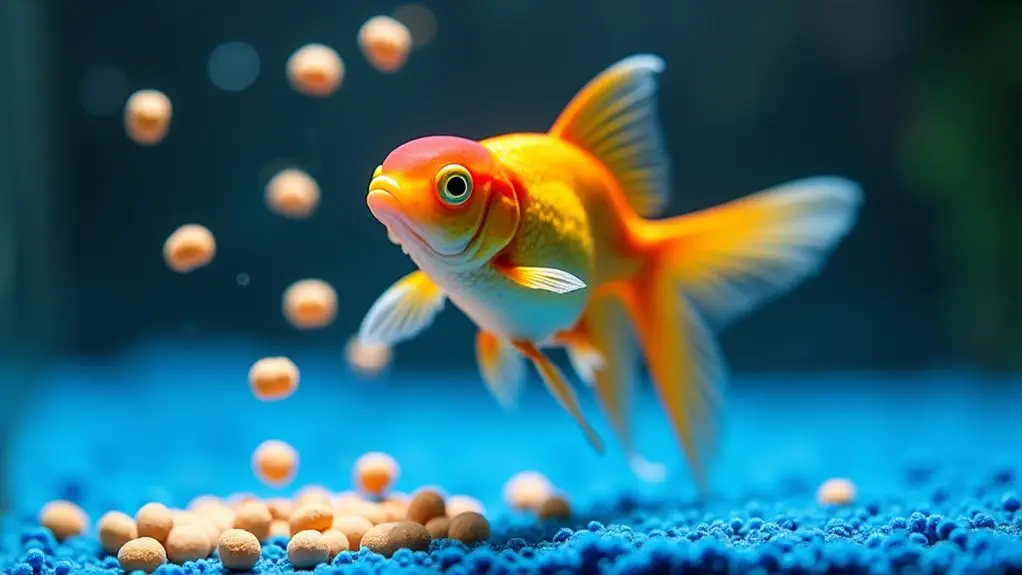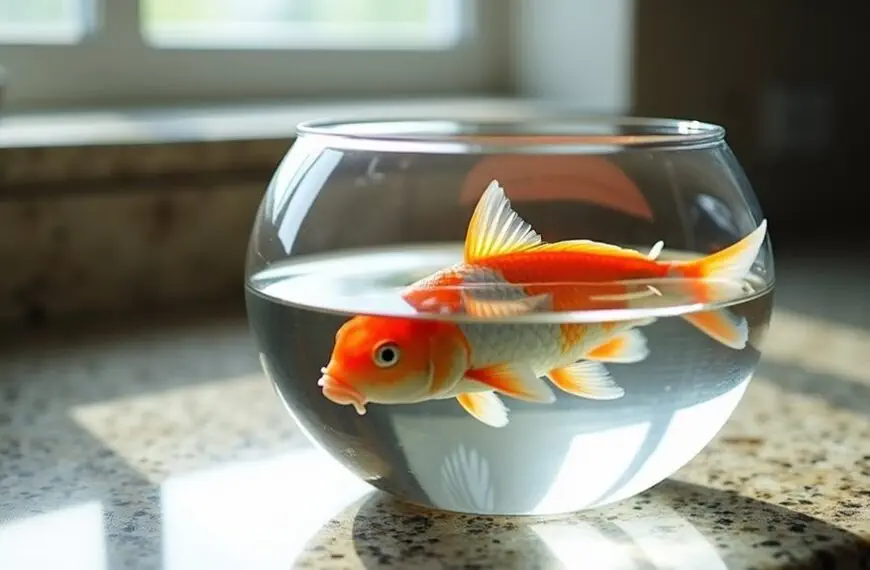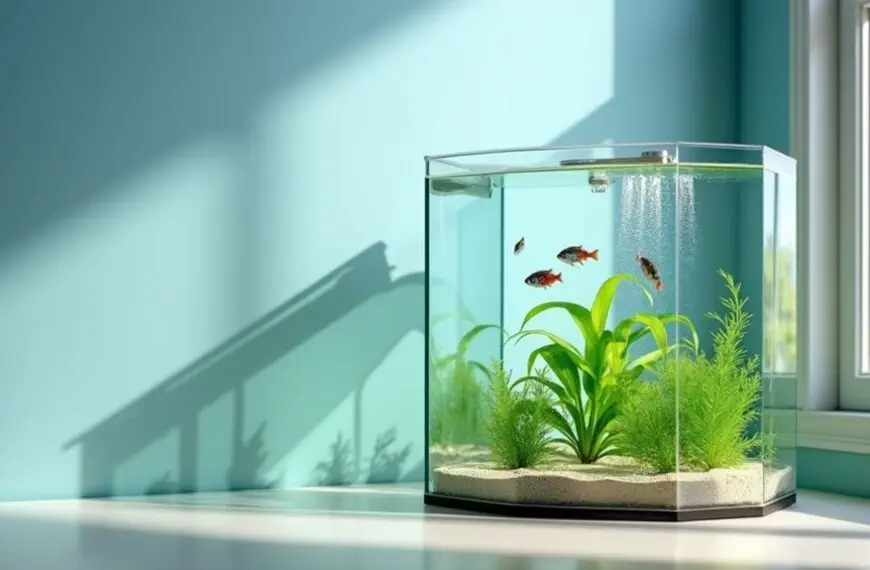Yes, you should feed your fish every day in most cases, but it's not a one-size-fits-all rule. Most aquarium fish thrive with once-daily feedings, though some species might need two or more meals per day. The key is to offer only what your fish can eat within 3-5 minutes to prevent overfeeding and water quality issues. Young fish often need more frequent meals than adults, while some species actually benefit from occasional fasting days. Watch your fish's behavior during feeding time – they'll show you if they're getting too much or too little food through their activity levels and overall appearance. Understanding your specific fish's natural feeding patterns will help you create the perfect menu plan.
Contents
- 1 Understanding Fish Feeding Basics
- 2 Common Fish Feeding Mistakes
- 3 Natural Feeding Patterns
- 4 Feeding Schedules That Work
- 5 Signs of Proper Feeding
- 6 Best Feeding Practices
- 7 Frequently Asked Questions
- 7.1 Can My Fish Survive on Vegetables Alone if I Run Out of Food?
- 7.2 Why Do Some Fish Spit Out Their Food Immediately After Eating?
- 7.3 Should I Feed My Fish Differently During Breeding Season?
- 7.4 How Long Can Most Aquarium Fish Survive Without Any Food?
- 7.5 Does the Color of Fish Food Affect My Fish's Feeding Response?
- 8 Final Thoughts
Understanding Fish Feeding Basics

In the world of fish keeping, understanding proper feeding practices is essential for maintaining healthy aquatic pets. Just like humans, fish have unique dietary requirements that stem from their fish biology and natural eating habits. Beginners should also consider species compatibility to ensure that all fish in the tank receive adequate nutrition without competition for food.
You'll need to take into account factors like species, size, and age when determining how often to feed your underwater friends. Most fish do well with once-daily feedings, though some species might benefit from eating twice a day. If you've got growing babies or slow grazers in your tank, they'll appreciate those extra meals. Regular observation of your fish's behavior is crucial for adjusting their feeding schedule appropriately.
On the flip side, those big predatory fish in your aquarium might only need to eat a few times a week – they're like the lions of the underwater world! It's best to feed most fish about 10-15 minutes after lights on to match their natural active periods.
The key to successful feeding isn't just about timing – it's about portion control too. You'll want to watch your fish's belly roundness and behavior during feeding time. Think of it as being their personal nutritionist!
A good rule of thumb is to provide only what they can consume within five minutes. Remember, when it comes to feeding fish, less is often more, and it's better to leave them slightly hungry than stuffed like a Thanksgiving turkey.
Common Fish Feeding Mistakes
You'll want to be extra careful not to fall into the common trap of overfeeding your fish, as this can quickly lead to toxic water conditions and serious health problems for your aquatic friends.
Getting the food type right is equally important, since feeding an herbivorous fish a carnivorous diet (or vice versa) won't meet their nutritional needs and can make them sick. Maintaining a consistent feeding schedule helps prevent disruption of natural feeding patterns and promotes better health. A good rule of thumb is to only provide what your fish can consume in 2-3 minutes.
When it comes to these feeding mistakes, think of yourself as a chef who needs to serve the right portion of the perfect meal – your fish will thank you with vibrant colors and active swimming.
Overfeeding Dangers and Consequences
Maintaining proper feeding portions stands as one of the most critical aspects of fish care, yet overfeeding remains a common mistake among aquarium owners. When you give your fish too much food, you'll notice clear overfeeding symptoms like bloating, lethargy, and difficulty swimming. Your finned friends might look like they're begging for more food, but don't let those puppy-dog eyes fool you! Many beginners make the mistake of thinking that more food equals better care.
The excess food you're providing doesn't just affect your fish directly – it wreaks havoc on your tank's water quality too. As uneaten food breaks down, it releases harmful substances like ammonia and nitrites, which can seriously stress out your aquatic pets. A consistent pattern of overfeeding can disrupt filtration systems significantly. Additionally, maintaining a routine of weekly water changes helps to alleviate some of the burden caused by excess waste.
You'll likely notice cloudy water, unpleasant odors, and potentially even algae blooms taking over your once-pristine aquarium.
To keep your fish healthy and your tank clean, stick to feeding only what your fish can consume in 3-5 minutes. If you're worried about portion control, try using a feeding ring or automatic feeder.
Wrong Food for Species
Frequently overlooked yet critically important, choosing the right food for your fish species can make the difference between a thriving aquarium and struggling inhabitants. Just as you wouldn't feed dog food to a cat, different fish species require species specific diets tailored to their unique needs. With the right foods, you can enhance the health of your fish and support their vibrant colors and activity levels.
Whether you've got herbivorous, carnivorous, or omnivorous fish, they each need their own specialized menu. You'll want to avoid the common mistake of using a one-size-fits-all approach to fish food. Your goldfish won't thrive on betta food, and your cichlids need different nutrition than your guppies. For instance, goldfish require 2-4 daily feedings to support their proper growth and development. Safe treats like freeze-dried worms can provide healthy variety in their diet.
When you don't match the food to your fish's natural diet, you're setting them up for nutritional deficiencies that can impact their health and longevity. Don't be tempted to toss in human food like bread or table scraps – these aren't designed for your aquatic friends and can cause digestive issues. Ensuring water quality is crucial as well, as poor conditions can exacerbate dietary problems.
Instead, focus on providing a varied diet of appropriate fish foods, including a mix of dried, frozen, and live options. Your fish will thank you with vibrant colors, active behavior, and better overall health.
Natural Feeding Patterns
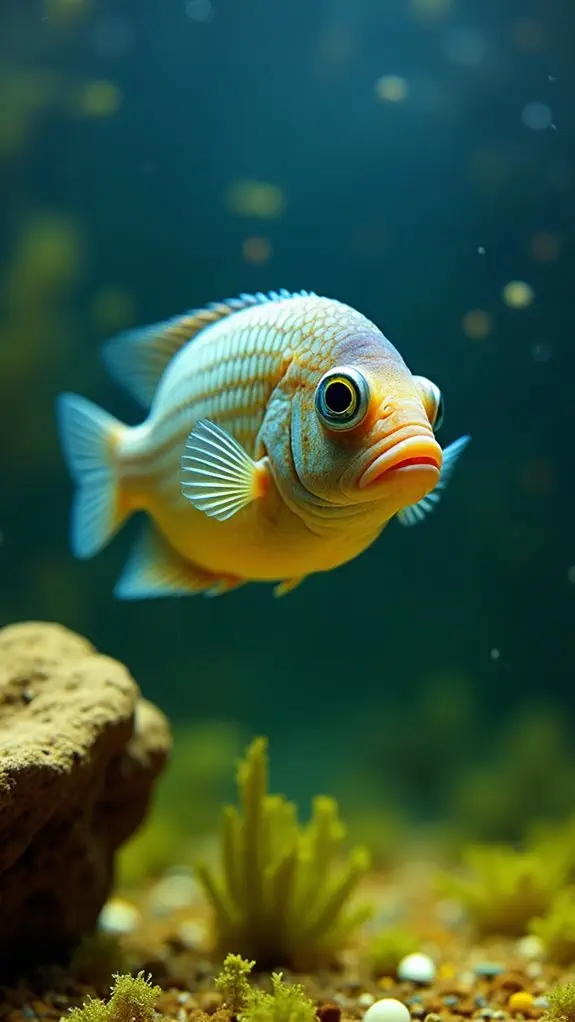
Fish display diverse feeding behaviors in their natural habitats, ranging from constant grazers to opportunistic predators. You'll notice that some fish, like herbivores, need to munch throughout the day, while others prefer their meals in smaller, frequent portions. Understanding these natural feeding patterns will help you provide the best care for your aquatic friends. Multiple small feedings are recommended over large, infrequent meals.
Your fish's dietary preferences are closely tied to their aquatic adaptations. For instance, if you've got carnivores, they'll thrive on protein-rich foods like live worms, while herbivores will happily graze on fresh veggies. The habitat influence in your tank plays an essential role too – fish tend to congregate where food is plentiful, just like they'd in nature. A proper diet for carnivorous fish should contain at least 45% protein.
When considering feeding strategies, remember that different species have unique approaches. Some dart around catching food in the water column, while others prefer to scrape algae from surfaces.
You'll want to match your feeding method to these natural behaviors. If you've got constant grazers, provide foods that can last in the tank, but for others, smaller, more frequent meals throughout the day might be your best bet.
Feeding Schedules That Work
Building an effective feeding schedule starts with understanding when and how often to feed your aquatic pets. While most fish do well with once-daily feedings, your feeding strategies should align with your fish's specific needs and natural behaviors.
You'll find that some species thrive on multiple small meals, while others are perfectly content with less frequent feedings. When planning schedule variations, consider your fish's size, age, and activity level.
If you've got smaller fish, they'll typically need feeding twice a day, while larger predatory fish might only need meals a few times a week. Think of it like having different meal schedules for a toddler versus a teenager – their needs just aren't the same!
The best time to feed most fish is during daylight hours, about 10-15 minutes after you've turned on their aquarium lights. However, if you're keeping nocturnal fish, you'll want to flip that schedule and feed them after dark.
Additionally, monitoring water quality is crucial to ensure a healthy environment for your fish and to prevent overfeeding issues.
Signs of Proper Feeding
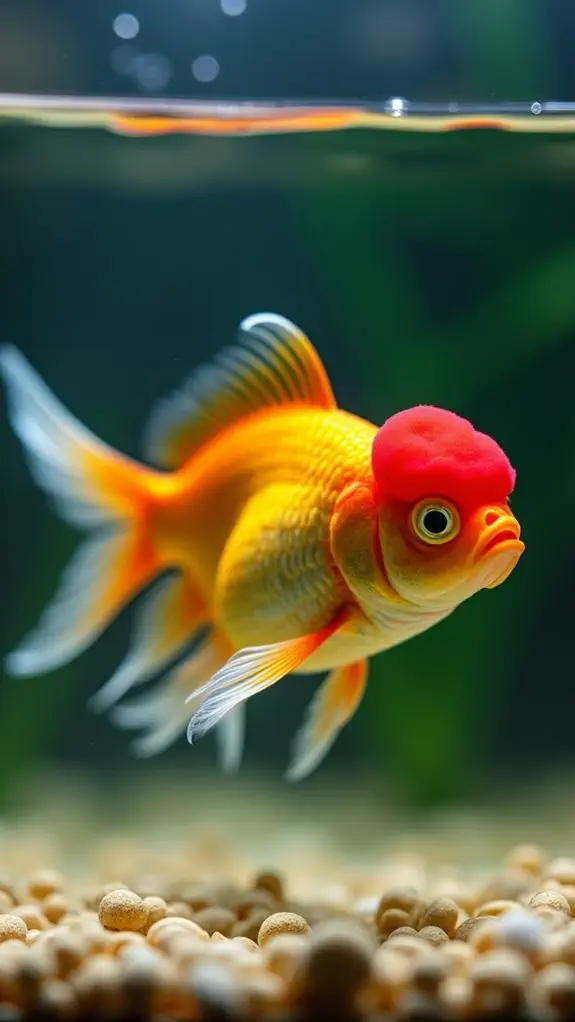
You'll know your fish are getting the right amount of food when they show bright colors, clear eyes, and sleek bodies that aren't too thin or too plump.
Their appetite should be consistent, and they'll enthusiastically swim up during feeding time while staying active throughout the day.
Your fish's body shape can tell you a lot about their feeding habits – look for smooth contours without bloating, and make sure they maintain a streamlined appearance that's typical for their species. Regularly monitoring water parameters is also essential to ensure that a stable environment supports their health and feeding behavior.
Visual Health Indicators
Throughout your fish-keeping journey, monitoring visual health indicators provides essential feedback about proper feeding habits. When you're doing your daily health assessment, you'll want to look for specific signs that show your fish are getting the right amount of nutrition. A well-fed fish will display vibrant colors, maintain proper swimming patterns, and show an enthusiastic response to food.
Here are key visual indicators that your fish's feeding schedule is on track:
- Smooth, healthy scales with no pale patches or fungal growth
- Clear, bright eyes without any cloudiness or swelling
- Active swimming behavior with proper buoyancy
- Clean tank bottom without excessive waste or uneaten food
- Fins that are held away from the body, showing no tears or decay
Your fish's appearance tells you a lot about their nutritional status. If you notice any changes in these visual indicators, it might be time to adjust your feeding routine.
Remember, a healthy fish is an active fish – they should keenly approach the surface during feeding time and maintain consistent swimming patterns throughout the day. Additionally, maintaining stable water parameters is crucial as fluctuations can impact your fish's health and feeding behavior.
Watch for these signs during your daily observations to verify your finned friends are thriving.
Appetite and Behavior
Understanding your fish's appetite and feeding behavior provides essential insights into their overall health and well-being. When it comes to feeding preferences, you'll want to observe how quickly your fish consume their food and guarantee they're eating within a five-minute window. If you notice food floating around after this time, you're likely offering too much.
Your fish's behavior during feeding time can tell you a lot about their health. They should appear keen to eat and maintain a slightly rounded belly after meals. Don't worry if you're occasionally feeding less than you think they need – it's actually safer to underfeed than overfeed your aquatic friends.
You'll find that your fish will quickly adapt to a regular feeding schedule, and they'll often be waiting for you at their usual mealtime (talk about dinner bell training!).
Remember to adjust portions based on your fish population and their sizes. If you've got different species in your tank, you'll need to take into account their individual feeding patterns – some might need frequent small meals, while others are content with fewer, larger portions. Additionally, maintaining water quality through regular water changes ensures that your fish are in a healthy environment to thrive.
Body Shape Assessment
Fish body shapes provide essential clues about their feeding requirements and ideal nutrition. By understanding your fish's body type, you'll be better equipped to develop effective feeding strategies that match their natural behaviors.
Think of it as tailoring a meal plan to your fish's unique lifestyle and abilities!
Here's what different body shapes tell you about feeding needs:
- Streamlined fish, like the speedy Blackmast, do best with medium-sized meals once or twice daily since they're built for constant swimming.
- Compressed-bodied fish prefer frequent small meals throughout the day, as they're natural grazers that love picking food from various surfaces.
- Bottom-dwelling fish with depressed bodies need sinking food that reaches them where they naturally feed.
- Elongated fish, like eels, thrive on multiple small meals that match their stalking behavior.
- Fish with unusual body shapes might need specialized feeding approaches to stay healthy.
When you're planning your feeding schedule, take a good look at your fish's body shape. This is especially important for ensuring you maintain optimal water quality that supports their unique dietary needs. It's like reading a blueprint for their dietary needs! This simple observation will help you provide the right amount of food at the right times, keeping your aquatic friends happy and healthy.
Best Feeding Practices
When you're establishing a feeding routine for your aquarium, proper practices can make all the difference in your fish's health and longevity. Your feeding techniques should focus on consistency and portion control, ensuring your finned friends get just the right amount of food at regular times each day.
You'll want to master the "2-3 minute rule" – only offer what your fish can completely consume within this timeframe. Think of it like serving a proper portion at dinner: you wouldn't want leftovers floating around! It's better to feed less than more, as overfeeding can lead to water quality issues and unhealthy fish.
To keep your aquatic pets thriving, mix up their menu with a variety of foods. You can alternate between quality commercial flakes, frozen treats, and even live food when appropriate.
If you're often busy or traveling, an automatic feeder can be your best friend, ensuring your fish get their meals right on schedule. Additionally, maintaining good water quality is essential as it directly affects the overall health and stress levels of your fish.
And here's a pro tip: consider implementing a weekly fasting day – it's actually good for their digestion, just like those intermittent fasting trends we humans try!
Frequently Asked Questions
Can My Fish Survive on Vegetables Alone if I Run Out of Food?
You can't feed most fish vegetables alone, as they need balanced nutrients. While some fish like Pacus and Mollies can handle a vegetable diet, most species require specific fish diet combinations for proper nutrition.
Why Do Some Fish Spit Out Their Food Immediately After Eating?
Your fish's feeding behavior might include spitting out food due to stress, poor water quality, or specific food preferences. They'll also spit food to break it into smaller pieces before eating.
Should I Feed My Fish Differently During Breeding Season?
Yes, you'll need to adjust your feeding approach during breeding season. Increase feeding frequency and offer protein-rich foods to support breeding behavior. Feed smaller portions more often, typically 2-3 times daily for most species.
How Long Can Most Aquarium Fish Survive Without Any Food?
Your fish's fasting survival duration varies by species, size, and health. Most aquarium fish can live 1-2 weeks without food, though some hardier species like goldfish and cichlids can survive up to 4 weeks.
Does the Color of Fish Food Affect My Fish's Feeding Response?
Your fish's feeding behavior isn't strongly influenced by food color, but their natural color preferences may affect how quickly they spot food. Most fish respond more to movement and smell than food coloring.
Final Thoughts
You've got all the tools you need to be a great fish parent now! Remember, most fish don't need daily feeding – it's better to match their natural eating patterns. Watch your fish's behavior, adjust their portions based on what they can eat in a few minutes, and stick to a consistent schedule. When you find the right balance, you'll see happier, healthier fish that'll thank you with their vibrant colors and active swimming.

